The New York Crystal Palace (Part 1)
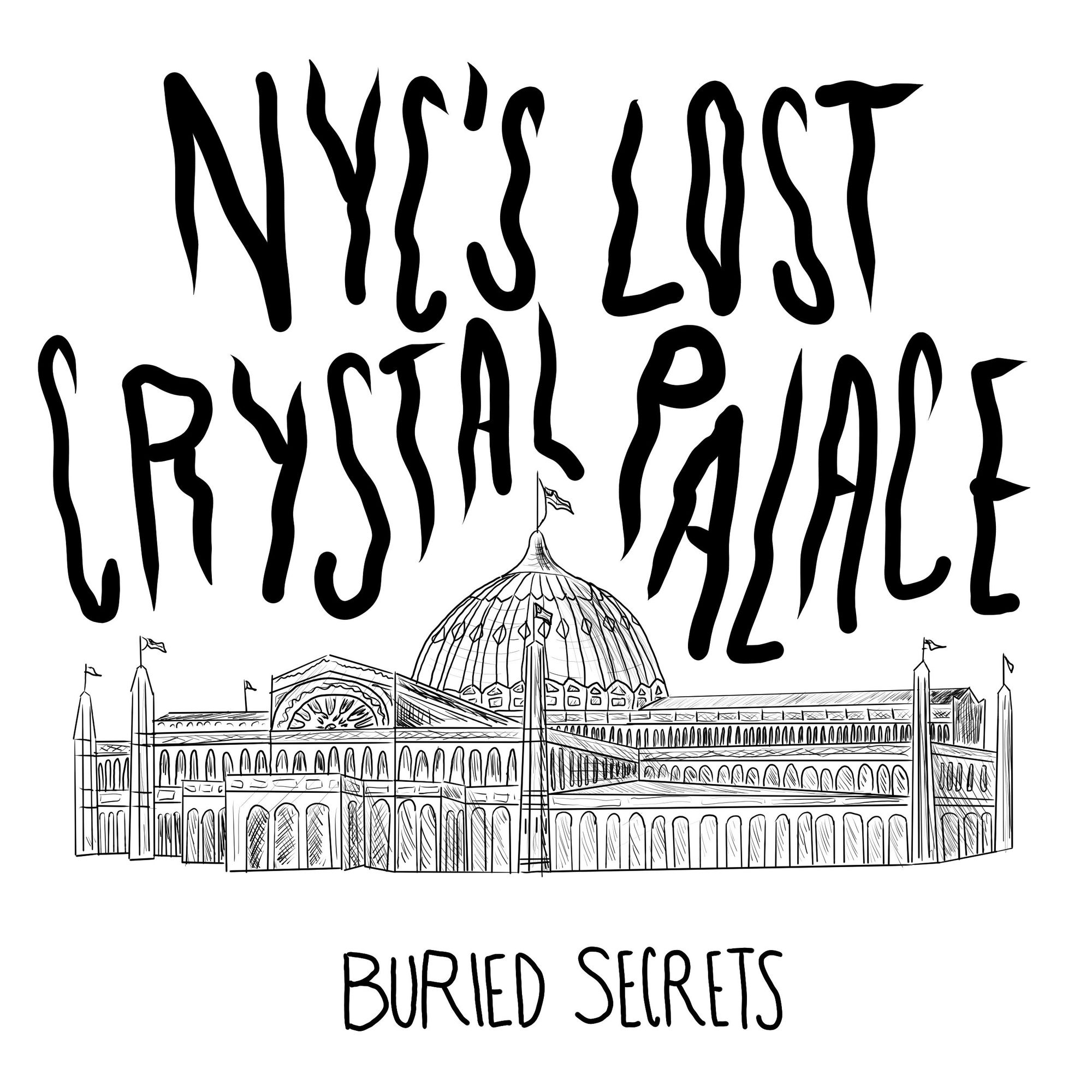
The New York Crystal Palace: A look at New York City’s ill-fated Crystal Palace, a beautiful structure built on an abandoned cemetery on the outskirts of town.
In the mid-19th century, a castle of glass stood in the wilds of what is now a bustling part of New York City. It was an answer to a similar Crystal Palace in London, which had hosted an exhibition a couple years before.
The Crystal Palace and the Exhibition of the Industry of All Nations was meant to represent American industry and ingenuity, but ended its days as a decrepit symbol of excess and mismanagement before going up in flames. Here’s part 1 of its story.
Highlights include:
• The story behind how NYC became a tourist destination
• Weird inventions like the “mechanical leech” and the “typeographer”
• The gardener-architect who built the world’s tallest fountain
• A sort of mini Eiffel Tower that sprouted up next to the Crystal Palace
Follow the podcast on instagram @buriedsecretspodcast
E-mail the podcast at buriedsecretspodcast@gmail.com.
Pictures of the Crystal Palace
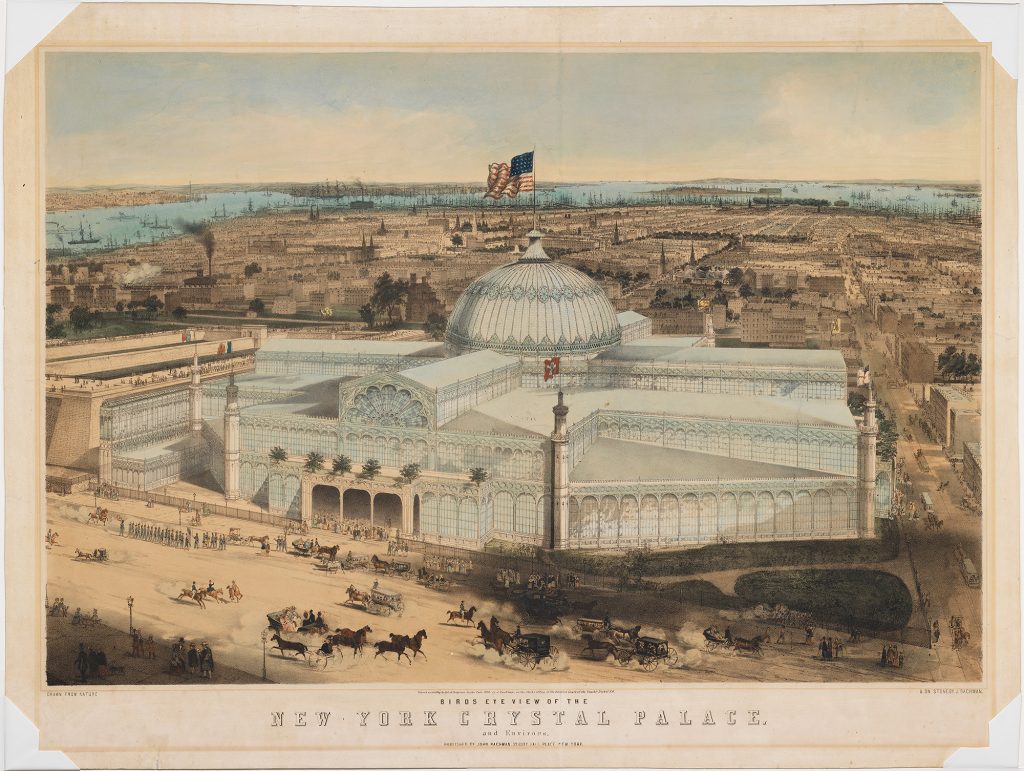
Birds Eye View of the New York Crystal Palace and Environs 1853 (from http://crystalpalace.visualizingnyc.org/)
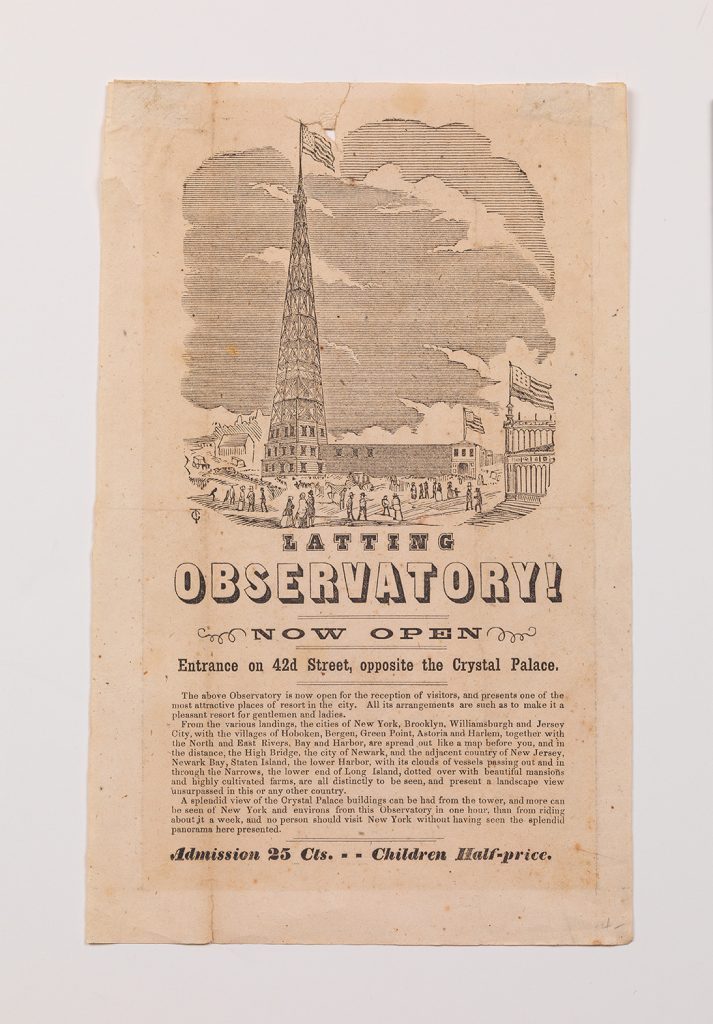
Latting Observatory broadside ca. 1853 (from http://crystalpalace.visualizingnyc.org/)
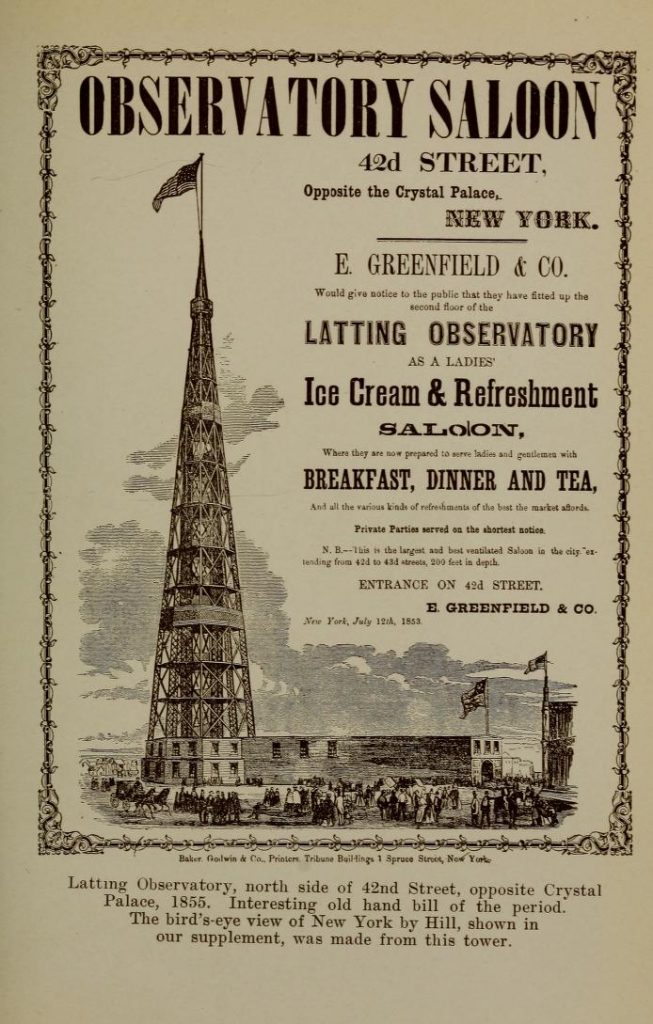
Latting Observatory from Valentine’s manual of old New York

August Petermann and Karl Gildemeister, designers; August Petermann, lithographer. New York Exhibition Building, 1852. Lithograph. Museum of the City of New York
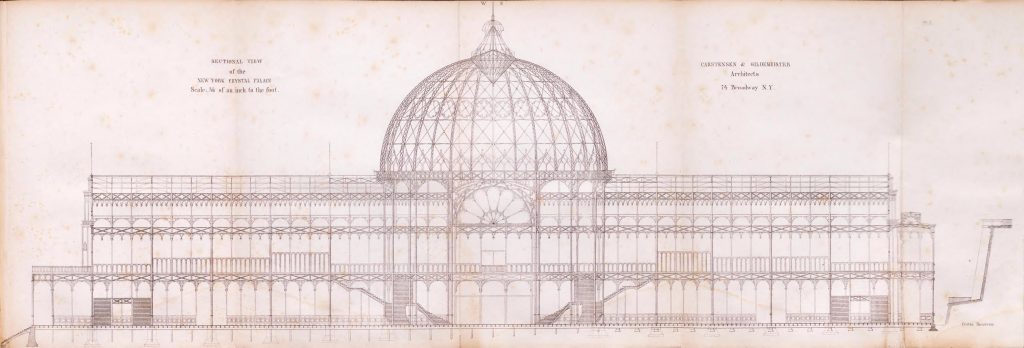
New York Crystal Palace Illustrated Description of the Building (from http://crystalpalace.visualizingnyc.org/)
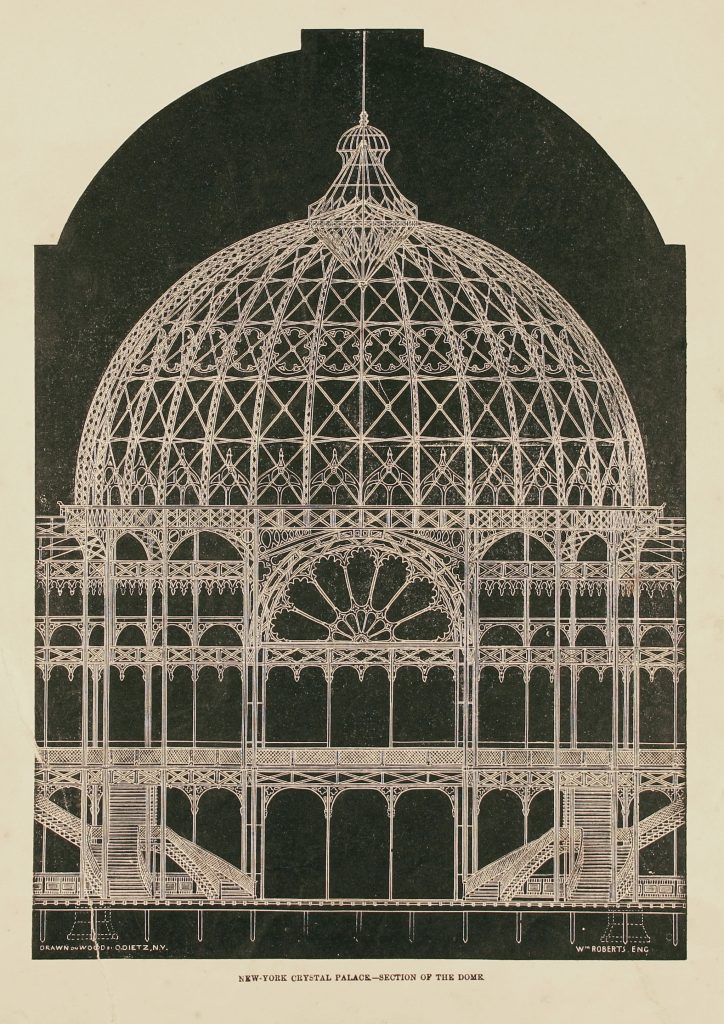
The Crystal Palace Dome (from http://crystalpalace.visualizingnyc.org/)
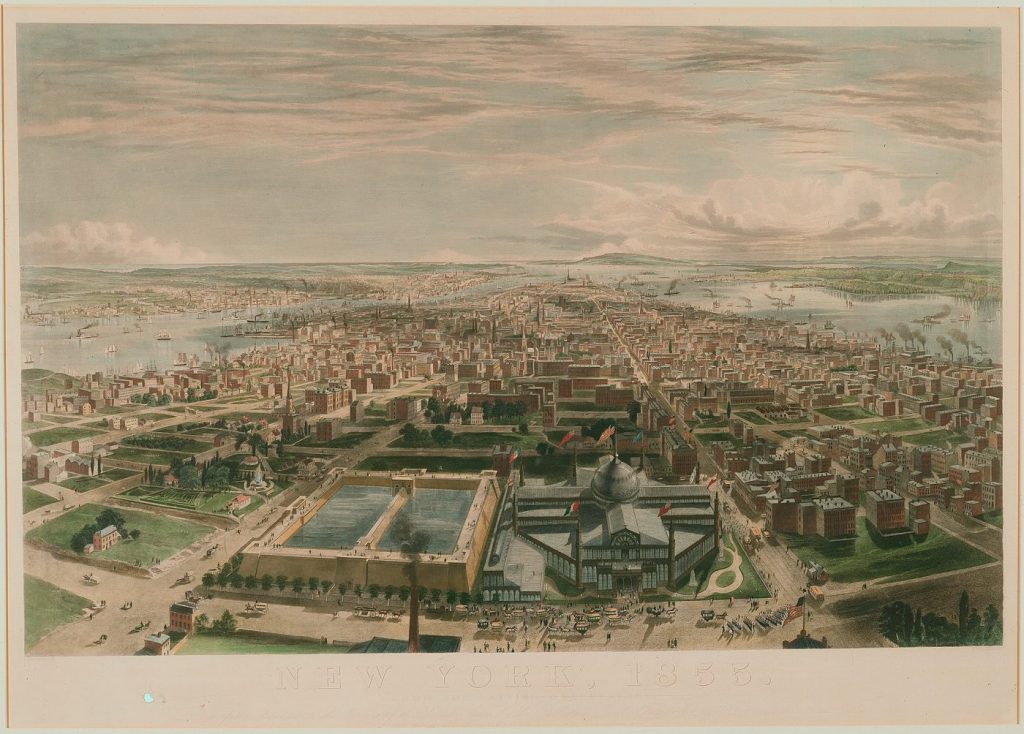
New York, 1855. From the Latting Observatory. (from http://crystalpalace.visualizingnyc.org/)
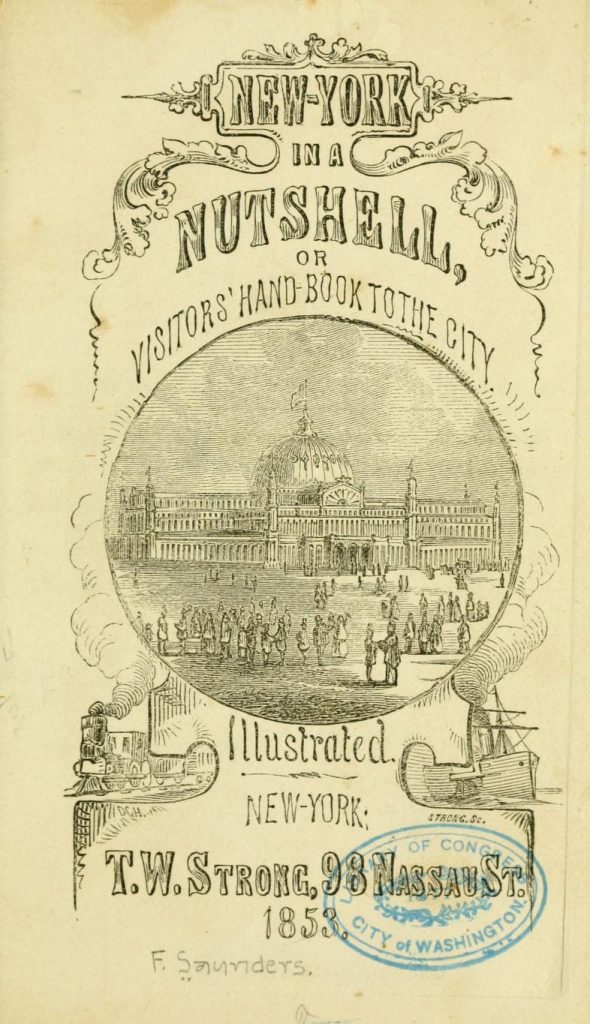
From New-York in a nutshell by Frederick Saunders

The Crystal Palace Exterior View. Victor Prevost, photographer, New York. 1853–54. Salted paper photograph (from http://crystalpalace.visualizingnyc.org/)
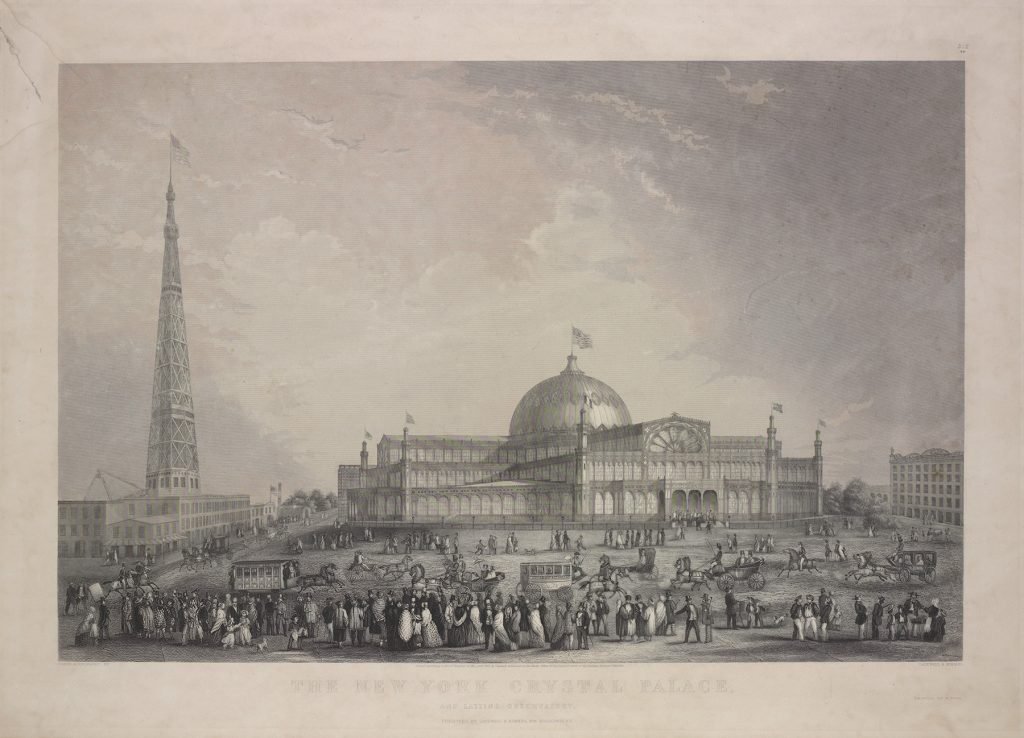
The New York Crystal Palace and Latting Observatory 1853 (from http://crystalpalace.visualizingnyc.org/)
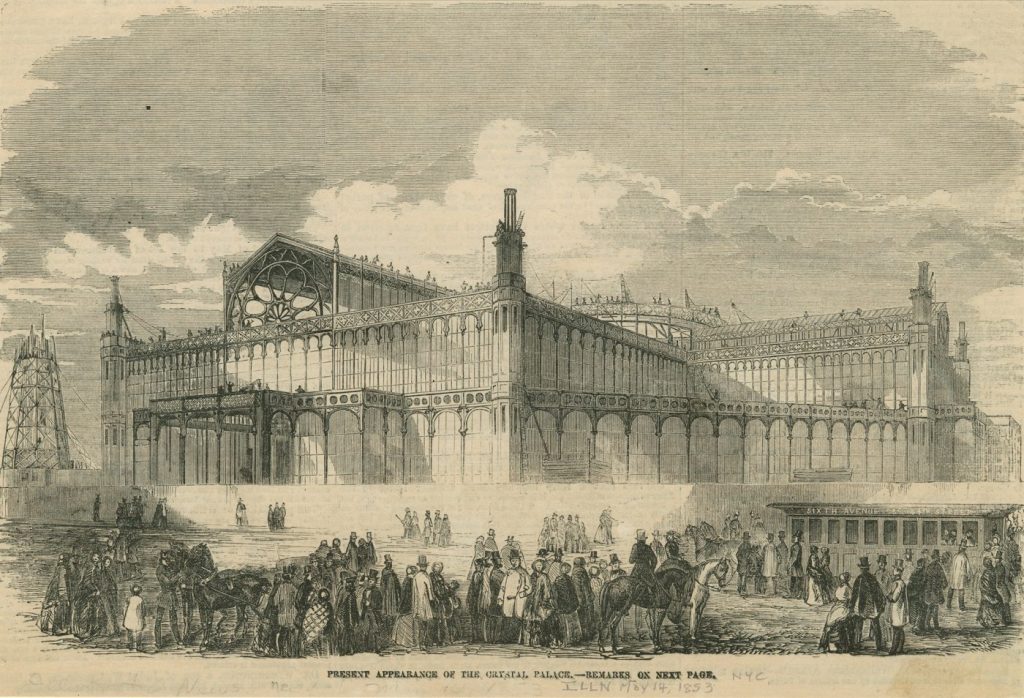
Present Appearance of the Crystal Palace (from http://crystalpalace.visualizingnyc.org/)
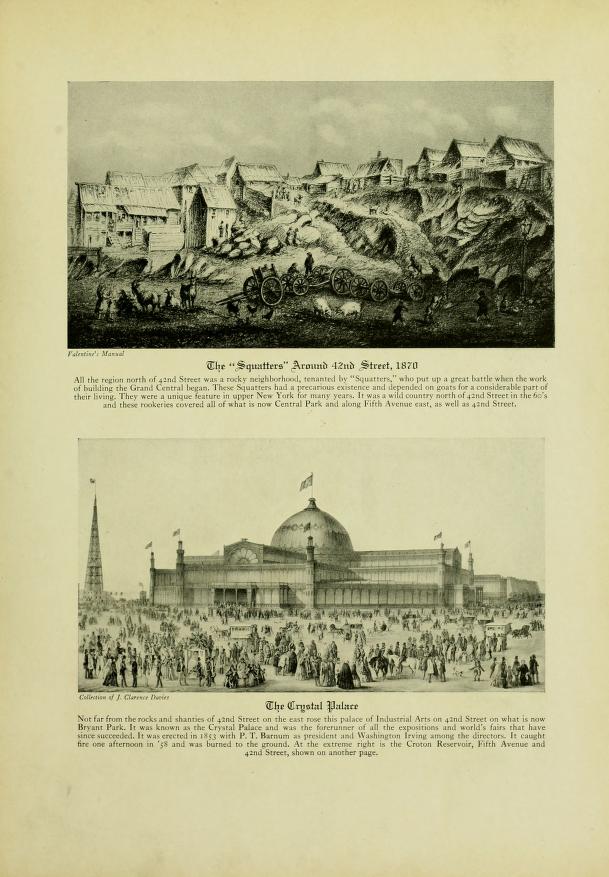
From Old New York yesterday & today by Henry Collins Brown, 1922

Birds Eye View of the New York Crystal Palace and Environs 1853 (from http://crystalpalace.visualizingnyc.org/)
Episode Script
DISCLAIMER: I’m providing this version of the script for accessibility purposes. It hasn’t been proofread, so please excuse typos. There are also some things that may differ between the final episode and this draft script. Please treat the episode audio as the final product.
Sources
- The main source for this episode is The Finest Building in America: The New York Crystal Palace 1853-1858 by Edwin G. Burrows (2015), though the full source list as always is in the shownotes at buriedsecretspodcast.com
Inspiration
- There had been a Crystal Palace in London, which had been an international sensation and which is still pretty famous today, even though the building no longer exists (it burned down in the 1930s).
- London’s Crystal Palace opened in 1851 in the bucolic setting of Hyde Park. It had tons of green space around it, and was really a beautiful setting.
- The palace was made of plate glass and cast iron, and it had the most glass ever used in a building. These were really new materials, and the technology to create sheet glass had only come about in 1832, so it really was groundbreaking.
- The architect was a gardener named Joseph Paxton, who at the time that he submitted his design, was the Duke of Devonshire’s Head Gardener for the Chatsworth House estate.
- If you’ve seen the Kubrick film Barry Lyndon, it was the filming location of Castle Hackton, or, if you’ve seen the 2005 Pride and Prejudice movie, that estate was the filming location for Pemberly, Darcy’s home.
- So at first I was wondering why a gardener would be qualified to do an architecture project, and was wondering if he was an amateur or self taught like a James Renwick Jr type. But I looked up Chatsworth House, and the improvements that Paxton made to its grounds, and during his tenure there, Paxton did a lot of design and architecture type projects, including:
- A rockery and pond
- A fountain that was built for a visit from Tzar Nicolas I, which was built in only six months (they had to work during the night using flares as light.) The idea was that it would be the tallest fountain in the world, which involved building a lake an 8-acre on the moors above the house so they could get the right water pressure. The fountain’s jets reached heights of 296 feet, so about as tall as a 21-story building, but the Tzar’s visit never happened, and Nicolas I died about a decade later without visiting Chatsworth.
- He also built the a lily house, which is where the giant Amazon water lilly was cultivated for he first time, as well as a set of greenhouses
- And one thing I wanted to mention that was related to the greenhouses: one thing that Paxton grew there was bananas, specifically Cavendish bananas (they were named after the Duke of Devonshire, his employer, whose name was William Cavendish.) Today, Cavendish bananas are the main type of bananas that are eaten around the world today. So if you’ve enjoyed a bananas recently, you can thank Joseph Paxton
- And, most importantly for our purposes here, he built the Great Conservatory, which was completed in 1841 and was the largest glass house in the world at that time. At the time, you couldn’t get sheet glass bigger than 3 feet long, but 4-feet pieces were specially made for the Conservatory. Since tropical plants were grown in there, it had to be heated, which was accomplished with 8 boilers and 7 miles of iron pipe. There was also a carriageway in the center, and when the Queen came by and was driven through, the Conservatory was lit with 12,000 lamps.
- Sadly, the Conservatory is no longer around: it was really expensive to maintain, and wasn’t heated during WWI, so all the plants died, and the Conservatory was demolished in the 1920s
- But basically the Conservatory was a testing ground for the Crystal Palace, so it makes a lot of sense that he was hired for the job–he had pioneered this new thing
- The Commission in charge of the Crystal Palace needed something build quickly and cheaply, and Paxton delivered: it took 2,000 men 8 months to build, and cost less than 80K pounds
- Visitors were stunned by, for example, how the building didn’t need lights inside, since it was illuminated by sunlight for the glass.
- 13,000-14,000 exhibitors came from around the world
- 6 million people were admitted to the exhibition between May and October 1851
- The Crystal Palace was 990,000 square feet
- It was so tall that it contained full-grown elm trees
- It was heavily publicized in America, and journalists wrote articles praising it, so the Crystal Palace in London became such a big deal in the states that, in typical fashion, Americans decided that we needed one too
- The idea that many elites had was that an American Crystal palace would increase industrialization by making people appreciate and want manufactured products. A lot of people had a lot of lofty-sounding ways of putting it, but basically it sounds like they wanted to teach people consumerism, especially poor people. Some folks seemed to think that young craftsmen could come and get ideas for new inventions and products, but for the most part, it seemed all about “civilizing” or “cultivating” poor rubes who, apparently, weren’t smart enough to know they needed a bunch of useless stuff.
- A Unitarian minister named Henry Bellows, who preached to a wealthy congregation, had this to say about the exhibition; it was “a great popular advertisement–a plan for letting the people know what is to be had, and who has it–a scheme for creating wants by exhibiting ingenious means of supplying them, and thus developing new forms of labor and new markets for them.”
- I just think this whole line of thinking is really gross.
- However, I do love the idea of the Crystal Palace, especially since the US didn’t have big museums like we do now, so it would be an opportunity for people to see great art and learn about interesting new technology. It’s just that I find the motivations of some of the Crystal Palace Association, who led to charge to construct a Crystal Palace in NYC, really despicable
- It’s important to remember that there was also a ton of civil unrest around this time, and the gap between the rich and the poor was widening a lot.
- Wealthy people spoke out often about how they needed to suppress workers rights and human rights movements, and poor people resented the people who were growing rich on their labor while also looking down on the laborers who created their wealth.
- This wasn’t an issue that was going to be solved by building a Crystal Palace, and maybe there’s a metaphor or joke here about throwing stones in glass houses, but at any rate, it was decided that NY would have its own Crystal Palace.
Construction and opening
- First, they needed to find a block to build it: the idea had been to construct the crystal palace further downtown, where Madison Square Park is now, but the rich people who lived near there objected.
- So, instead, they located it in what today is the heart of midtown but back then was an undeveloped area of muddy empty lots: 42nd street, on the east side of 6th avenue.
- You may remember this location from two past episodes:
- In the Victorian Egyptomania episode, I talked about the Croton Reservoir, a giant Egyptian revival structure that held the clean water that came from upstate via the Croton Aqueduct. There was a promenade around the top that people would stroll around, but on the whole, it was apparently known as a pretty grim structure, and didn’t last that long.
- And then also, in the Potter’s Fields of Manhattan episode, I talked about how they attempted to build a nice cemetery beside the reservoir, but the ground was swampy and gross, and no one wanted to buy plots, so it became a potters field. Most of the people buried there had died from cholera, pneumonia, smallpox, tuberculosis, and typhoid fever.
- The Reservoir was where the main NYPL building, the one with lions in front, and which was featured in ghostbusters, stands now. And the potter’s field was where Bryant Park is today.
- So the site of the former potter’s field on Reservoir Square is the location that the city allowed the Crystal Palace to be built in.
- Not exactly an auspicious beginning, to be put in a spot where even a cemetery hadn’t been able to flourish.
- It’s unclear exactly what happened to the bodies when the Crystal Palace was built. The book The Graveyard Shift: A Family Historian’s Guide to New York City Cemeteries, says:
- “The remains in this cemetery may have been removed to another burial ground in 1852 to make way for The Crystal Palace, an entertainment venue, which opened on this site the following year.”
- A ton of famous architects submitted proposals for the building, but the design by two foreign architects, a Danish man named Georg Carstensen and a German man named Charles Gildemeister, won.
- Carstensen had been one of the architects of Tivoli Gardens, in Copenhangen, which is still around today.
- Things didn’t really go well with the architects.
- First, the budget for the building was $200K. Their plan called for a budget of $300K, they claimed, though really it would have cost more than that.
- Some cost-saving measures really hobbled the construction. For example:
- There was supposed to be a basement level. That was important because 1) it would have elevated the whole building by 6 feet, allowing it to obscure the huge Croton Reservoir behind the Crystal Palace, and 2) it would have allowed a beautiful fountain to be installed.
- However, the basement level was nixed to save money, which really ruined the intended impact of the palace
- The fountain was replaced by what was, by all accounts, a hideous statue of George Washington
- There was supposed to be a basement level. That was important because 1) it would have elevated the whole building by 6 feet, allowing it to obscure the huge Croton Reservoir behind the Crystal Palace, and 2) it would have allowed a beautiful fountain to be installed.
- The architects were blamed for everything that went wrong with the construction, which took longer and was more expensive than planned, though it doesn’t sound like it was really the architects’ fault.
- The architects were supposed to be paid $5K, but were only ever paid $4K
- Carstensen returned to Copenhagen in 1855 and supposedly died penniless and forgotten there in 1857
- Gildemeister returned to Germany in 1857 and died in 1869
- Neither of their deaths were really remarked upon in the American press, which seems right, since during the opening ceremonies of the Crystal Palace and other publicity, the architects were neither honored or mentioned, really
- People flocked to the palace’s construction site to watch it being built, which was apparently a grand sight, even though construction wasn’t going so well
- Aside from the delays caused by argument, cost-cutting, and mismanagement, there were other hold-ups, like a hailstorm that killed 3 workers, broke a bunch of windows, and flooded the exhibition floor (FBA 68)
- Across the street from the Crystal Palace, an enterprising inventor named Waring Latting began construction of a strange looking structure called the Latting Observatory.
- It was a large octagonal observation tower which had a 75-foot-wide base and came to a small point at the top, where it was only 6 feet wide.
- It afforded panoramic views of the area, which had never been seen before, in this time before aviation and tall buildings.
- At 27 stories tall, it was the tallest building in NYC, and one of the tallest human-made structures at the time. The only taller structures were the Great Pyramid at Giza and some European Cathedrals (FBA 70)
- If you look at images of the NY Crystal Palace, you’ll usually see the tall, pointy Latting Observatory beside it, so much so that people often thought it was part of the exhibition (it wasn’t)
- But it wasn’t the only structure to pop up and capitalize on the crowds of visitors to the Exhibition–there’s a great quote from the NYT at the time:
- “There are Crystal Stables, and Crystal Cake Shops, and Crystal Groggeries, and Crystal ice-cream Saloons. One old woman has set up a Crystal Fruit Stall, at which oranges and bananas, in every stage of decomposition may be purchased. We noticed a dilapidated hovel on Sixth-Avenue, which was called by its proprietor the Crystal Hall of Pleasure.” (FBA 54)
- Basically, in real NY style, everyone who could profit off of the excitement over the palace did so, with gusto. The area around the Crystal Palace became somewhat seedy, and plenty of people moralized about it.
What was displayed inside the crystal palace?
- There were 4,300 exhibits from 6,000 contributors from 23 foreign countries
- The initial idea was that it would be way better curated and organized than London’s Crystal Palace, which some people had said felt cluttered and confusing
- This is a pretty good illustration of the Crystal Palace in general–you know, it’s creators are like, “We’ll do everything better than they did in London” and then they did the opposite
- So the exhibition in London has 30 categories of items, and the America exhibition, which was supposed to be simplified, had 31–they added a category for musical instruments. Some of the other categories were “substances used as food”, “philosophical instruments,” “mixed fabrics,” wearing apparel,” and “fine arts” (FBA 107) Fine arts included at least 675 paintings, for example, so they definitely went hard on this.
- Basically, the exhibition had lots of cool things, though also junk. The list included: a map of the US drawn by a public school student, stomach pumps, a “mechanical leech,” birdcages, doorbells, wigs, fake diamonds, sugar tongs, iceboxes, clothes, a much more. A NYT reporter wrote: “The mind becomes very quickly exhausted from the quantity of material crowded on the view and very soon produces additional physical lassitude. To-day we saw may faint-looking and wearied persons, looking sorrowfully around for some place to rest themselves.”
- One visitor called it “a wilderness of objects”
- Gaslights weren’t installed until later on in the summer, so some things were so in shadow that you just couldn’t tell what they were, especially items on the east side of the building, where they ended up in the shadow of the reservoir until the afternoon.
- And even if you could see something, there often wasn’t anyone who knew what it was who could explain it to you, and things didn’t seem to be well labeled.
- There also weren’t many new innovations that hadn’t been previously displayed or revealed elsewhere, aside from an electric motor and an early typewriter called a “typeographer”
- Mostly the exhibition was noteworthy because there was so much stuff.
- Also, the machine arcade, where all the machines were held, got really loud, especially the part that had looms, spinners, and other textile manufacturing machines–it really sounds pretty overwhelming
- A 124-year-old man, who had been enslaved and owned by George Washington, was intended to be displayed as a curiosity at the exhibition. A writer from the London Weekly News wasn’t impressed by the exhibition as a whole, and wrote “What do you think of the showing up of a slave as an article of American manufacture?” (FBA 84-85) It’s unclear if this person was ever displayed, but it sound like he wasn’t, thankfully.
Responses
- Until the Crystal Palace was built, people in the US vacationed in the countryside. It wasn’t really a thing for people to go into cities to see the sights there.
- If they went to the city, it was only to transfer trains on their way to a more bucolic location.
- John Dalberg, an English historian, writer, and politician, who was famous for saying “Power tends to corrupt, and absolute power corrupts absolutely.”, had this to say of NYC at the time:
- “There is little to be seen in New York; it is not a fine city.”
- So basically, people might travel to cities for work, but there weren’t really tourist attractions in the city, as we understand them now.
- That all changed with the Crystal Palace–suddenly, NYC became a destination for folks.
- So when all the rich people left NYC in July and August (much like they do now), tourists came in to see the Crystal Palace
- A 17-year-old Samuel Clemens–who would later be known as Mark Twain–went to the Crystal Palace and was transfixed. He’d recently moved to NYC, and wrote to his family back in Hannibal, Missouri, that the it was “a perfect fairy palace–beautiful beyond description.” (FBA 87)
- Walt Whitman, whose famous book Leaves of Grass would be published the next year, in 1855, was a young poet from Brooklyn at the time, visited the Crystal Palace so many times that the cops became suspicious and started following him around. He returned so many times to look at a Danish statue called Christ and his Apostles, which people said was the best piece of art at the exhibition. (FBA 94)
Issues
- So, you might be wondering what happened to the Crystal Palace. If it was this beautiful and beloved structure, so why isn’t it still there?
- If you’ve been listening to the show for a while, you can probably the answer to this: the NY Crystal Palace, like so many beautiful buildings in history, burned down.
- But this building didn’t just burn down–after all, buildings are destroyed in fires all the time, but their stories often survive. So why did people just sort of forget about the Crystal Palace, and why wasn’t it rebuilt?
- So, from the beginning, the Crystal Palace Association had financial issues.
- In February 1854, stockholders learned that even though the Association had earned $350K in ticket sales from the 1.2 million people who visited the exhibition, they still owed their creditors $125K. (That’s about $3.8 million in today’s dollars.)
- They’d even had to mortgage the building
- So the Association got a new board of directors of 25 men, which was made up of many business magnates, bankers, and lawyers, and also included Horace Greeley, the editor of the New York Tribune. Greeley was a real character–I find him pretty delightful–and supported causes like socialism, vegetarianism, feminism, temperance, and of course, the abolition of slavery. He was kinda an interesting choice for the board, I think, but also he was a really important figure in NY at the time, so in that way, it makes sense.
- Well, Greeley had a friend who also made it onto the board, someone who was actually controversial: one Phineas Taylor Barnum, aka PT Barnum, the famous showman.
And we’ll pick back up next week, and take a look at what PT Barnum did to try to save the Crystal Palace, as well as the disaster that claimed the palace.
Sources consulted
Books
- The Finest Building in America: The New York Crystal Palace 1853-1858 by Edwin G. Burrows (2015)
- The Graveyard Shift: A Family Historian’s Guide to New York City Cemeteries by Carolee Inskeep (2000)
- How to See the New York Crystal Palace: Being a Concise Guide to the Principal Objects in the Exhibition as Remodeled, 1854 by the Association for the Exhibition of the Industry of All Nations
- A Day in the New York Crystal Palace and how to Make the Most of it: Being a Popular Companion to the “Official Catalogue,” and A Guide to All the Objects of Special Interest in the New York Exhibition of the Industry of All Nations by William Carey Richards
- Official Catalogue of the New-York Exhibition of the Industry of All Nations, 1853
- Art and Industry as Represented in the Exhibition at the Crystal Palace in New York 1853 by Horace Greeley
- Old New York yesterday & today by Henry Collins Brown, 1922
- New-York in a nutshell by Frederick Saunders
- Valentine’s manual of old New York by Henry Collins Brown, 1919
- New York Crystal Palace: Illustrated Description of the Building
- Fifteen Minutes Around New York by George G. Foster, 1854
- Guide to the Crystal Palace and Park, Volume 1 by Samuel Phillips
Articles
- A Mammoth Tree. NEW-YORK CITY. New York Daily Times (1851-1857); New York, N.Y. [New York, N.Y]09 Aug 1855: 1
Websites
- https://en.wikipedia.org/wiki/The_Crystal_Palace#The_Great_Exhibition_of_1851
- https://en.wikipedia.org/wiki/Latting_Observatory
- https://en.wikipedia.org/wiki/New_York_Crystal_Palace
- http://crystalpalace.visualizingnyc.org/digital-publication/
- https://nypost.com/2018/02/03/nycs-first-architectural-wonder-went-down-in-flames/
- https://en.wikipedia.org/wiki/New_York_Crystal_Palace
bgc.bard.edu/gallery/exhibitions/3/new-york-crystal-palace-1853 - https://www.boweryboyshistory.com/2015/03/the-crystal-palace-americas-first-worlds-fair-and-bizarre-treasures-of-the-19th-century.html
- https://books.google.com/books?id=XRNBAAAAYAAJ&printsec=frontcover&dq=crystal+palace+new+york+guide&hl=en&sa=X&ei=NCcMVabVJ8elgwTkhoPABQ&ved=0CB0Q6AEwAA#v=onepage&q=crystal%20palace%20new%20york%20guide&f=false
https://books.google.com/books?id=9ecZAAAAYAAJ&printsec=frontcover&dq=crystal+palace+new+york+guide&hl=en&sa=X&ei=NCcMVabVJ8elgwTkhoPABQ&ved=0CCIQ6AEwAQ#v=onepage&q=crystal%20palace%20new%20york%20guide&f=false - https://lithub.com/the-question-of-homoeroticism-in-whitmans-poetry/
- https://en.wikipedia.org/wiki/John_Dalberg-Acton,_1st_Baron_Acton
- https://en.wikipedia.org/wiki/Gilded_Age
- https://en.wikipedia.org/wiki/Horace_Greeley
- https://en.wikipedia.org/wiki/P._T._Barnum
- https://en.wikipedia.org/wiki/Metropolitan_Museum_of_Art
- https://aleteia.org/2019/10/07/thorvaldsens-christus-was-once-considered-the-most-perfect-statue-of-christ-in-the-world/
Don’t miss our past episodes:
- The Renwick Ruin:
- Investigating the Hawthorne Hotel:
- The Haunted Grove Park Inn, Asheville, North Carolina
- Haunted Asheville, North Carolina
- New York City Potter’s Fields
- Calvary Cemetery, Queens, New York (Part 1)
- Archbishop John Hughes, aka Dagger John: Calvary Cemetery, Queens, New York (Part 2)
- The Haunted Luxor Hotel and Casino, Las Vegas: Part 1
- The Haunted Luxor Hotel and Casino, Las Vegas: Part 2
- A Victorian Lunatic’s Fort: Fort Maxey, Blackwell’s Island, NYC
- The Roosevelt Island Lighthouse, or The Blackwell Island Light, NYC
- The General Slocum Disaster, Hell Gate, New York City
- The Haunted Hell Gate, New York City
- Haunted St. Mark’s Church-in-the-Bowery

